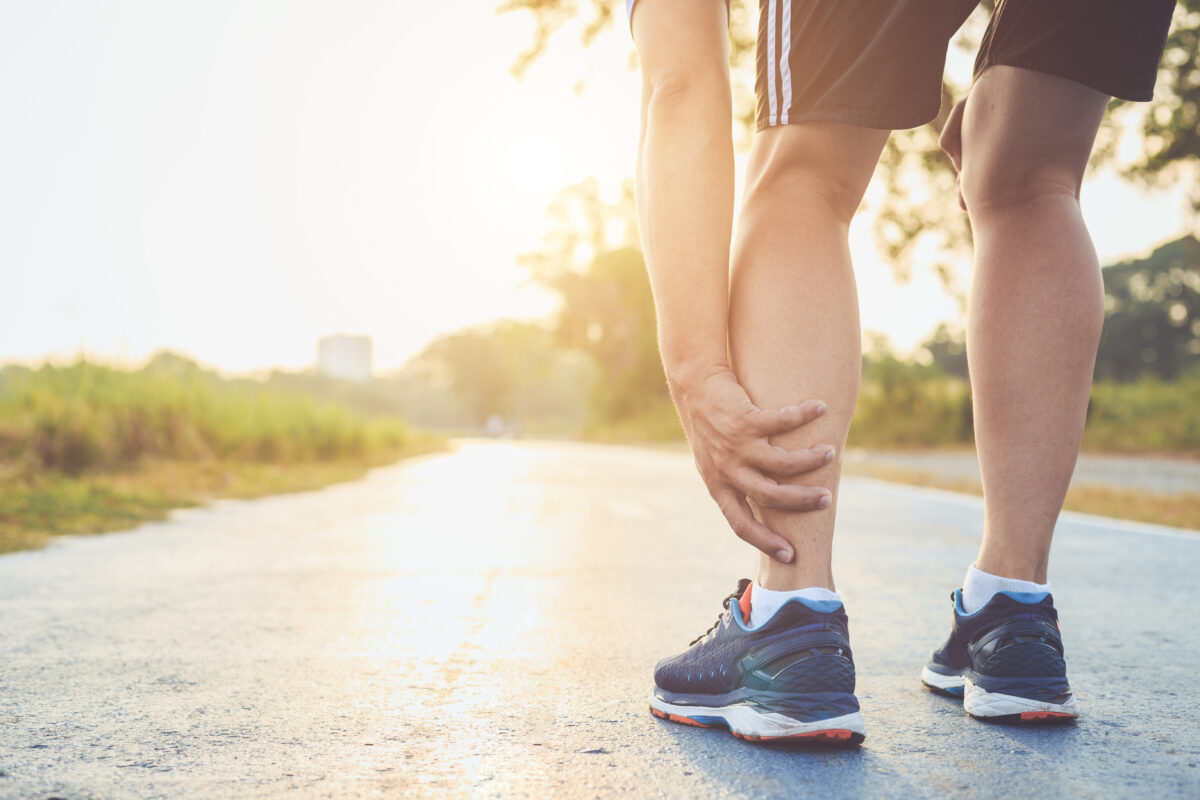Muscle Strains: Mechanisms and Management

Strained muscle injuries are highly common. They are frequent in high demand sports and account for up to 55% of all sporting injuries. They also commonly occur as a result of everyday physical activities. Muscle strains occur more frequently as people age, and take longer to recover from in older adults.
Muscle fibers are categorized into slow twitch (type 1) which provide endurance and fast twitch (type 2) which fatigue faster but provide powerful bursts of movement. These fibers are both present in every skeletal muscle, but the relative amount of each type varies in different muscles. Most muscle strains occur in muscles with a higher percentage of fast twitch fibers, and in muscles which cross two joints. The most commonly strained muscle groups are the hamstrings and rectus femoris and the medial head of the gastrocnemius.
A muscle strain may occur through direct trauma to the muscle, which is seen most often in contact sports. Direct trauma can cause injury to the muscle and microscopic damage to the sarcolemma, the membrane of individual muscle cells. Muscle strains also commonly occur when a muscle changes rapidly from active shortening (concentric motion) to active lengthening (eccentric motion). This mechanism is seen more often in non-impact sports or during physical activities of daily life. These injuries commonly afflict the myotendinous junction as this is the weakest point in the muscle-tendon unit. In this case, injury at the microscopic level occurs within the myofibril, the subunit of individual muscle cells.
Most muscle strains are managed conservatively at home, and the cornerstone of initial treatment is the RICE approach. Initially the strained muscles are rested to prevent further injury, iced for 15-20 min every few hours to decrease initial swelling and inflammation, gently compressed with an elastic bandage and elevated above the level of the heart to decrease swelling.
The use of nonsteroidal anti-inflammatory medications (NSAIDs) in the acute treatment of muscle strain is common to decrease pain and inflammation at the site of injury. There has historically been some controversy about the use of anti-inflammatory medications immediately after muscle injury. This stems from data from some animal model studies which suggested that NSAID use may cause delayed muscle regeneration and decrease the tensile strength of injured muscles. Other similar studies did not see this effect, however, and studies in humans have shown that NSAID use reduces strength loss, soreness and blood creatinine kinase levels (a marker of muscle breakdown) after muscle injury.
Physical therapy has also been shown to be effective for a variety of muscle strains. Physical therapists commonly use therapeutic exercises to strengthen surrounding musculature and restore functionality to a strained muscle. This is commonly done in conjunction with massage and mobilization of the strained muscle, joint and nerve manual therapy, and other modalities such as therapeutic ultrasound.
There has been some recent interest in using growth factors as a method to enhance functional recovery after muscle injury. The use of growth factors which cause muscle growth, proliferation and differentiation such as IGF, NGF and b-FGF as well as inhibitors of muscle-fibrosis inducing TGF-β1 have been studied as possible treatments for muscle strain. A similar approach using the body’s own growth factors to improve skeletal muscle regeneration is platelet rich plasma (PRP). This treatment has become increasingly used in patients with a variety of sports related injuries. However, a recent trial demonstrated no benefits of PRP compared to placebo in patients with muscle injuries up to one year after injection.
Muscle stains are extremely common and the best available evidence suggests treatment with a combination of RICE, NSAIDs and physical therapy. The use of therapies to target specific growth factors is promising, but more data on the safety and effectiveness of these treatments is needed before they are offered to people with muscle strain.
References:
Tidbal GH. Mechanisms of muscle injury, repair, and regeneration.Compr Physiol. 2011 Oct;1(4):2029-62.
Baoge L, Van Den Steen E, Rimbaut S, Philips N, Witvrouw E, Almqvist KF, Vanderstraeten G, Vanden Bossche LC. Treatment of skeletal muscle injury: a review. ISRN Orthop. 2012 Apr 26;2012:689012.
Maffulli N, Del Buono A, Oliva F, Giai Via A, Frizziero A, Barazzuol M, Brancaccio P, Freschi M, Galletti S, Lisitano G, Melegati G, Nanni G, Pasta G, Ramponi C, Rizzo D, Testa V, Valent A. Muscle Injuries: A Brief Guide to Classification and Management. Transl Med UniSa. 2014 Sep 1;12:14-8.
Baker BA. An Old Problem: Aging and Skeletal-Muscle-Strain Injury. J Sport Rehabil. 2017 Apr;26(2):180-188. doi: 10.1123/jsr.2016-0075.
Ramos GA, Arliani GG, Astur DC, Pochini AC, Ejnisman B, Cohen M. Rehabilitation of hamstring muscle injuries: a literature review. Rev Bras Ortop. 2016 Dec 15;52(1):11-16.
Morelli KM, Brown LB, Warren GL. Effect of NSAIDs on Recovery From Acute Skeletal Muscle Injury: A Systematic Review and Meta-analysis. Am J Sports Med. 2018 Jan;46(1):224-233.
Laumonier T, Menetrey J. Muscle injuries and strategies for improving their repair. J Exp Orthop. 2016 Dec;3(1):15.
